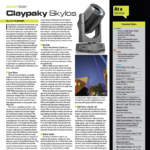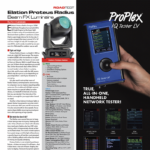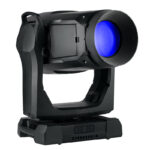Chauvet Professional showed the world the prototypes for their new stellar line of fixtures, dubbed the Maverick Series, at the Prolight + Sound show in Frankfurt last April. This only whetted my appetite; I have waited a couple of months to get my hands on the first fixture of this series to be released, the Maverick MK2 Wash. Rest assured, the fixture lives up to its hype as a powerful wash light with some tasty effects.
The Maverick MK2 wash has 12 individually operated LED cells on the face. There are nine trapezoid shaped ones that surround the outer circumference of the face and three different shaped cells in the center. The cells are recessed in a honeycomb frame with a clear bubble protecting them. I grab the 32-pound fixture by its yoke and plop it on end. The outer covering is designed for easy access to any part of the fixture and made from a black polymer material designed to protect the fixture from the usual rigors of day-to-day use.
I plug it directly into a wall outlet. The auto-sensing power supply recognizes voltage between 100-240V AC. At 120V the fixture draws 5.5 amps. There are four modes one can run this fixture in. Basic 20-channel mode is fine if you do not wish to have individual control of every cell/pixel. There is an advanced mode that requires 122 channels for the fixture and allows for fine color tuning on each LED emitter. This could benefit someone using these fixtures with a lot of pixel mapping. There is a tour mode that takes 146 channels and allows the user to have individual intensity control of each cell as well as the color. I choose the Standard Dual Mode, which utilizes 68 DMX channels and offers me individual color control of each cell. It’s called “Dual Control” because the fixture acts as two separate fixtures once patched, which is common with these type fixtures.
I feed it DMX through a 5-pin XLR, though I note a 3 pin XLR and the fixture’s ability to be controlled by Art-Net, sACN, wireless DMX or Kling-Net.
The First Part of the Fixture
The fixture has one part that controls the pan and tilt, zoom, reset, shutter and intensity for the dimmer. It moves incredibly fast taking 1.3 seconds for the fixture to pan 540°. I note that in the personality settings for controlling the fixture one can set the maximum pan rotation to be a simple 360 or 180° limit as well. Similar option with the tilt. The response time this fixture takes in executing a command that will reverse its direction is minimal. There is no hesitancy whatsoever in the fixture when put it into a can-can tilt effect as it instantly reverses direction on command. It executes a perfect circle effect quickly, without diminishing in size when sped up (a fault very common in competitive fixtures).
The motorized zoom function moves the LED cells of the fixture back and forth at lightning speed, retracting them into its shell like a turtle. I can narrow the beam down to a respectable 7° to achieve that ACL beam look. I zoom it very evenly over five seconds until it reaches its maximum size at 49°. I put a sine wave on the zoom effect, and it runs incredibly fast. The fixture is very silent, even before I test the optional setting to turn the fans off. I left for lunch with the light on and the fans off in a hot warehouse. I came back and found zero heat issues.
The light beam itself is plenty bright for a small footprint wash fixture. I meter 850 foot candles from a 20-foot distance when zoomed tight. Chauvet claims the fixture emits 19,000 lux from the same distance. The beam itself meters out close to 10,000° K on the color spectrum. There is an overall color temperature that can knock it all the way down to a tungsten-equivalent 2,800° beam as well.
The shutter and dimmer are both electronic. In the settings, one can choose the dimmer curve they fancy for any particular show. The Linear, Square wave, or S Curve. One can also choose the dimmer speed to be fast or smooth. I set the dimmer to be linear and fast. The light reacts precisely like other LED fixtures, but I want to check out this Smooth speed option. WOW, is all I can say. The fixture can be put in this mode and the dimmer reacts similar to one on a typical conventional fixture, it slows down so it takes half a second to black out. This is a handy feature many programmers could take advantage of in theatrical shows. The dimmer is indeed smooth and gets all the way down to 2 percent intensity before it totally blacks out. The typical random and sync strobe effects exist, but I like the great patterns emitted from the pulse-strobe effects as well.
There is one cool setting I found on the light that deals with the sudden loss of data. One can choose whether they would like the light to just stay put in its last state before command was lost (beneficial should the console lose power) or if the fixture should black out until it receives signal again (good for a concert when a black out cue is fast approaching and you will catch all hell if a bank of lights stay on).
The Second Part: Color and Pixel Command
The first thing I note is that the user doesn’t have proprietary command over the dimming of each cell in my chosen mode, and I wish I had used the touring mode. There is only a master dimmer channel. But one must remember that if you give no color values to the fixture (like adjusting the RGBW LEDs at zero), no light will go through the black filter. So users quickly get used to doing any individual pixel control with colors to turn each cell on and off individually. It saves the user another 24 channels per light. The minimal tradeoff is that one has to fade to black by changing color or using the master dimmer channel.
The 12 Quad color LEDs are each Osram 40W units with a life expectancy of 50,000 hours. No wonder this baby has so much horsepower, even in the blue color. I match this fixture up to a couple of other leading competitors just to see if this blue color they rave about is true. Yes sir, they can boast all they want. I get a nice rich blue hue out of the light that puts other fixtures to shame. The yellow is pretty spot on as well if I reduce the green hue a notch. Lavender and teal colors are mediocre (as expected with most LED color mixing).
There is a channel for color presets one can use if in a hurry. They refer to it as color macros, and there is a separate channel for fading time between macros. As far as color mixing, the user can choose whether they want the light to be run in additive mode (0 to 100 percent) using RGBW or in subtractive mode (100 to 0 percent) using CMY values. These can be changed at any time though a control channel value in the cue.
Perhaps the coolest functions of the fixture are the built in macro channels for helping out with pixel mapping and eye candy effects. It’s a virtual gobo wheel in a sense, scrolling through preprogrammed macros gives one a whole plethora of options of individual cell dimming and color patterns. Lastly, the fixture comes with a channel called Background Color Macros. This is a great unique concept. Say the user wants to use a macro that alternates between a red X and a red Y that is used in a color blinking macro, but they want the background of all cells not being used in each step to come on in blue. There is a separate speed channel for the backgrounds as well. Pure genius.
At a Glance
A Full-Function Wash
With full pixel mapping, virtual gobo wheel with background colors, pre-programmed colors and a 7° to 49° zoom range, the Maverick MK2 Wash from Chauvet Professional gives users a wide range of options on how to best put the fixture’s 40W Osram LED cells to use. Programmers can opt to control each cell by both color and intensity or use fewer DMX channels in Dual Control mode. The fixture’s quick pan and tilt movements are impressive; so is the motorized zoom. Other pluses include ample brightness, adjustable color temperature, compact footprint, silent operation, no overheating issues and super-smooth dimming.
Maverick MK2 Wash
PROS: Bright output, rich blue color, fast movement, background color macros, superior zoom.
CONS: As with most fixtures using LED color mixing, lavender and teal hues are less-than-ideal.
FEATURES: 16-bit Dimming
- Built-in Color Presets
- Built-in Virtual Gobo Wheel
- DMX, WDMX, S ACN, Art-Net and Kling-Net Compatible
- Converts TCP/IP Protocol to DMX for shorter data cable runs.
- True 1 Compatible Power Input
STATS:
- Size: 12.7” x 9” x 18.5”
- Weight: 32 lbs.
- Power: 660 watts
- IP Rating: IP20
- MSRP: $3,749.99
- Manufacturer: Chauvet Professional
- More Info: www.chauvetlighting.com



